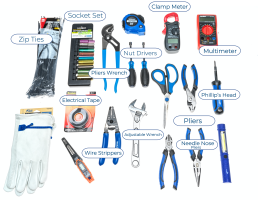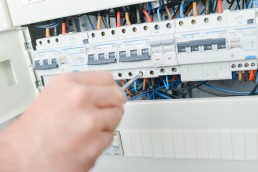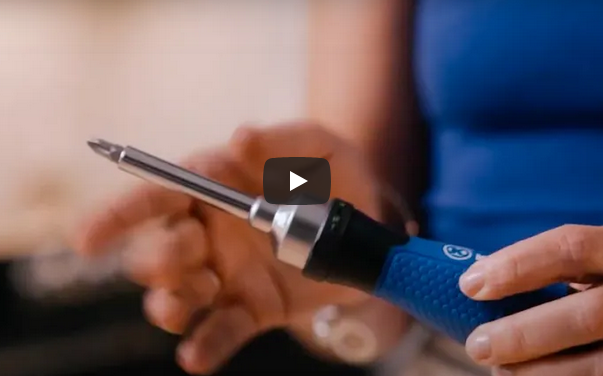HVAC Appointment Preparation
Before the start of your appointment, have all the necessary tools ready! If you ordered a replacement part, verify the correct part was sent.

We highly recommend these tools for HVAC repair.
Necessary tools you will need:
- Pocket thermometer: Thermometer($15-20).
- Either a clamp meter or a multimeter. Preferably a Clamp Meter ($15-25)
- A Phillips head screwdriver #2 tip
- Both 1/4″ and 5/16″ nut drivers or socket set from 1/4″ to 5/16″
- Open-end wrenches or box wrenches from 1/4″ to 5/8″
- Wire strippers
- Electrical tape
- A flashlight
- Pliers
- Work gloves
- Batteries for your meter
- A fully charged phone
- Our Vision Live app for Android or iOS is required to communicate with your technician (also linked in your appointment email)
*Meter advice – If you just purchased a meter and may plan to return it, leave it unopened until your tech directs you to use it.
A stable connection.
Ensure the internet connection you are using for your chat session has enough bandwidth. Others that are also using your internet service may interfere with the repair session if they are using online activities such as live gaming, live movie streaming, or downloading large files at the same time as your repair session.

Our Top Tools For HVAC Repair
We recommend the tools listed below for your virtual appointment. Not all tools are required, but the ones listed under necessary tools are a must-have! Having these tools makes your appointment with any technician go smoothly and as quickly as possible, giving you the confidence you need to repair your HVAC! While some repairs demand specific tools, many just require basic tools you might already own. We’ve put together a list of the top tools every do-it-yourselfer should have.
Screwdrivers
Make sure you at least have a flat-head and a Phillips screwdriver. Consider buying a screwdriver that has an interchangeable bit. They are inexpensive and prepares you for most jobs!
Adjustable open-end wrench
Just as its name suggests, the jaw on the wrench is adjustable to accommodate various sizes of nuts and bolts.
Multi (Voltage) Meter
A mulit meter safely checks for voltage and indicates the presence of electricity. You can buy one for under $10-20 at any Walmart or home improvement store. *Make sure you have batteries for your meter!
*Meter advice – If you just purchased a meter and may plan to return it, leave it unopened until your tech directs you to use it.
Clamp Meter
A clamp meter safely checks for current in an electrical system without disconnecting/deenergizing it. You can get one for $15-25 at any Walmart or home improvement store. *Make sure you have batteries for your meter!
*Meter advice – If you just purchased a meter and may plan to return it, leave it unopened until your tech directs you to use it.
Electrical Tape
Electrical tape is a safety tape for wires. You use it to cover and insulate wires and other materials that conduct electricity. You can buy different colors if you want to identify different wires you are working on.
Flash Light
You will want extra lighting when looking into certain parts of your system. We suggest an inexpensive LED flashlight with a magnet at one end. A magnetized flashlight is great to place anywhere you are working to help illuminate your workspace and allows you a free hand.
Work Gloves
Even the simplest repairs can expose you to sharp edges or hot surfaces, so wear work gloves to protect your hands.
Rags and towels
Rags and towels have many uses besides cleaning up any water spills and grease or dirt when working on your system. You can also use them to place small parts and screw on for visibility so you do not lose them.
Pliers
Needle-nose pliers are perfect for gripping small pieces; they also can bend or cut wires. Slip Joint Pliers can help you easily release clamps. Channel-lock pliers can help loosen fittings.
Open-End Wrenches
Open-end wrenches are used for loosening and tightening fasteners such as nuts and bolts.
Zip Ties
Zip ties are used to bundle cables, wires, and tools together. Extra-long heavy-duty ties are used to tie up flexible air ducts and air connectors, allowing for quick and secure installation.
Masking tape and a pen or permanent marker
This is a “must-have” when removing screws, disconnecting wires or hoses. The easiest way to correctly reassemble any item removed from your unit is to label where it came from. We also recommend you take pictures with your phone each step of the way so you can see exactly how it looked before you removed any part from your appliance.
Safety goggles or glasses
Safety eye-wear is a necessity for protecting your eyes from particles or chemicals during repairs.
Nut drivers or Socket Set
1/4″ and 5/16″ nut drivers are a must-have for any repairs around the house. HVAC units use these to common nut sizes. If you have a socket set that will work great as well.
Wire Strippers
Wire strippers are used to remove the insulation from electric wires so you can repair, work with the wire, or to splice wires together.
Don't get electrocuted.
- Know the location of your home or apartment circuit breaker.
- Make sure you are able to unplug the appliance during the repair for safety.
- Keep small children and pets in a safe location away from the repair session.


Keep track of your steps and pieces!
Place small removed parts in plastic sandwich bags. Insert a labeled sticky note into the bags indicating where the parts came from.
A large (light-colored) towel may be helpful to place removed parts making them easier to see and identifying your work area.
Taking a picture of each step of the repair may assist you when putting back appliance parts.
Want more help preparing to repair your system?
Book an appointment with our Neli technicians and they will walk you through the diagnosis and prep you for the project using video screen sharing, texting and phone conversations!

